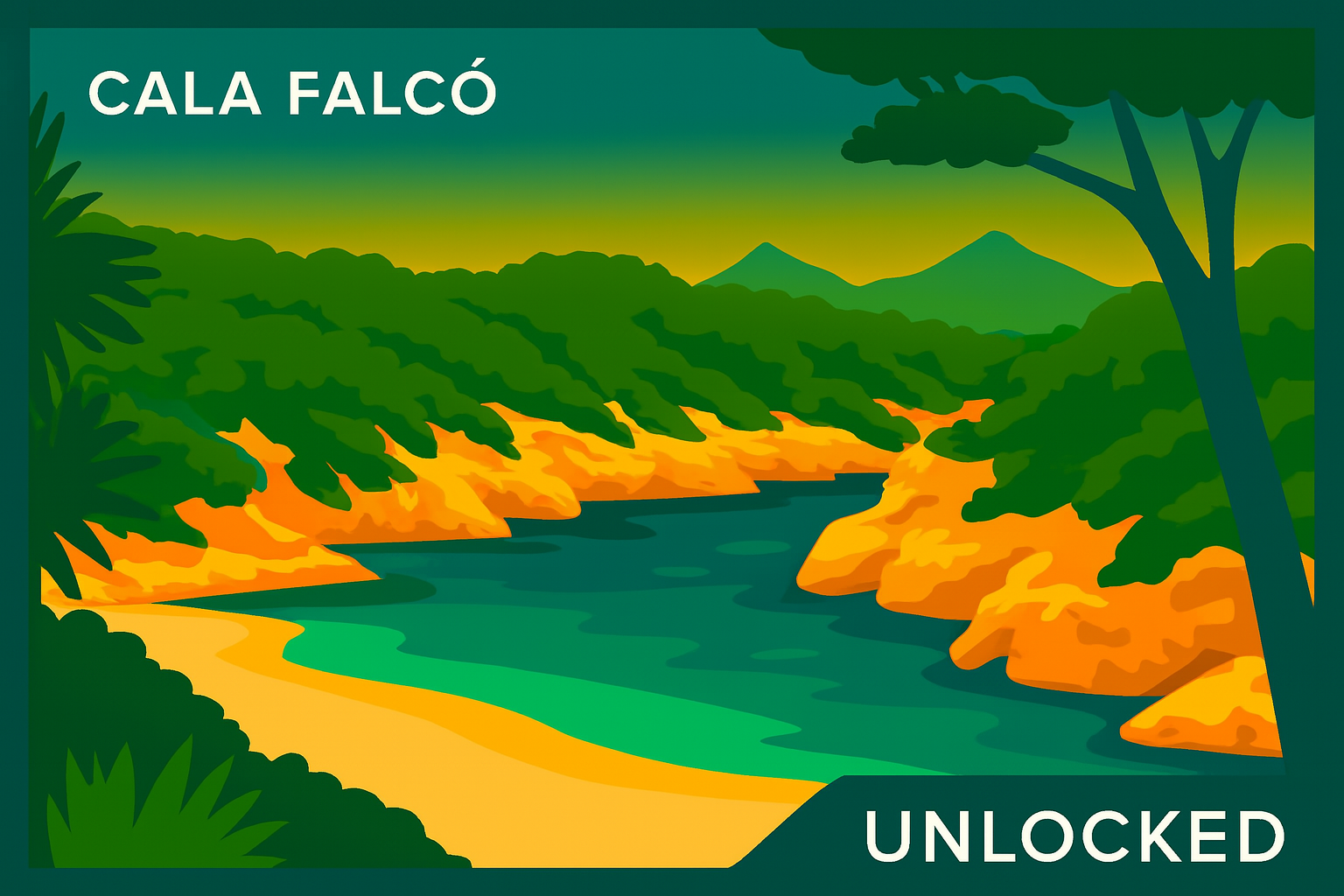
Cala Falcó
The Insider's Compass
How to Get to This Cove
Wherever you're staying in Mallorca, most coves are hard to reach without a car. We recommend booking one in advance to save money and move freely around the island.
🔍 Compare Car Rental DealsCala Falcó: A Guide to Calvià’s Wild and Secluded Jewel
Just a few kilometres from the neon-soaked strips of Magaluf, where the pulse of mass tourism beats its relentless rhythm, lies a place that feels like a whispered secret. Cala Falcó is more than just another beautiful beach on a postcard; it’s a pocket of defiance, a small, U-shaped inlet of rustic tranquillity carved into the wild coast of Calvià. It is a study in contrasts: a jewel-like cove where the branches of ancient pine trees dip down to touch the turquoise water, yet which has historically drawn a “boho-chic” crowd seeking an exclusive, stylish refuge.
To visit Cala Falcó is to step into a more elemental Mallorca. It’s a place that demands a little effort—a drive down an unmarked road, a careful descent down steep stone steps—but the reward is a palpable sense of discovery. Here, the island’s raw beauty is the main attraction, a sensory experience defined by the scent of pine and salt on the air. But this cove holds deeper stories. Just beyond its placid waters, the seabed is a silent museum of ancient maritime trade, holding the ghosts of both Greek and Roman vessels. And on its shores, the very nature of the visitor experience is in flux, evolving from a serviced paradise to a self-sufficient sanctuary. This is the unfiltered story of Cala Falcó, a guide to its enduring beauty and its changing soul.
Why You’ll Fall for Cala Falcó
The first thing you notice at Cala Falcó is the profound sense of peace. The cove is wrapped in a thick embrace of pine groves that cling to the low, ochre cliffs, providing dappled shade that shifts with the sun. The beach itself is a compact crescent of fine, white-golden sand, only about 50 metres long but surprisingly deep, offering just enough space to lay a towel before the forest begins again.
A Tale of Two Vices: Raw Nature and Quiet Exclusivity
This profound natural serenity has long been complemented by a distinct social current. For years, the cove was dominated by a trendy beach club that cultivated a “chilled vibe,” attracting a stylish, affluent clientele alongside the local families who have always cherished this spot. This created a unique blend of rustic nature and quiet exclusivity, a place where you could feel utterly removed from the world, yet still be part of a scene that appreciates beauty, tranquillity, and the luxury of a well-kept secret. While the future of its amenities is uncertain, the legacy of this atmosphere remains, woven into the very fabric of the cove.
A Swimmer’s Paradise
The water at Cala Falcó is almost preternaturally calm and clear. Its shallow entry and protected nature make it an irresistible invitation to swim, snorkel, or simply float. The flanking cliffs provide excellent shelter from most winds and open sea swell, resulting in the calm, lake-like conditions that define the cove. It’s a place where you can swim with confidence, exploring the rocky ledges and gazing back at the stunning frame of green pines and golden sand.
Uncovering the Secrets of the Coastline
To truly appreciate Cala Falcó, you need to understand its place in the world, both geographically and historically. Its sheltered position has not only shaped its character but also made it a silent witness to millennia of Mediterranean history.
A Sheltered Nook in Calvià’s Wild Heart
Precise geography is crucial here, especially as Cala Falcó is often confused with a cove of the same name on Mallorca’s opposite coast, in the municipality of Manacor. The true Cala Falcó, the subject of this guide, is firmly located in the southwest of the island, within the municipality of Calvià, just over 5 km from Magaluf.
It is a classic Mediterranean cala, a U-shaped sea inlet carved between two headlands: Platja de sa Bella Dona to the north and Cap des Falcó to the south. This geography is its greatest asset. This natural protection has not gone unnoticed by the sailing community; the bay is an optimal and popular spot for boats to anchor, with a sandy and seaweed bottom providing good holding at depths of 3 to 4 metres. From the shore, the small islet of s’Illot del Sec is visible about half a nautical mile away—a seemingly innocuous landmark that hides a history of immense significance.
Ghosts of the Mediterranean: Shipwrecks and Sunken Treasure
The tranquil waters off Cala Falcó belie a dramatic past. The view towards s’Illot del Sec is a window into over two millennia of maritime history, a story told by two separate, extraordinary shipwrecks that are often conflated into one. The first is a 4th-century B.C. Greek vessel, one of the first of its kind found in Spanish waters. Discovered in the 1940s, it was a treasure trove of Attic pottery and bronze cauldrons. Tragically, its recovery in the 1970s was crudely handled with explosives, damaging the site but cementing its archaeological importance.
More recently, and just a short distance away in the Bay of Palma, a storm in 2019 revealed an even more spectacular find: the Ses Fontanelles wreck. This 4th-century A.D. Roman merchant ship was astonishingly well-preserved by the sand. Archaeologists have recovered nearly 300 amphorae, many still sealed, containing wine, olive oil, and garum—the prized fermented fish sauce of the Roman world. The painted inscriptions on these jars, called tituli picti, represent the largest collection ever found in Spain, offering priceless insights into trade routes between the Iberian peninsula and Italy. Together, these two wrecks establish this small stretch of coastline as a vital, ancient shipping lane.
The Cathedral Quarries of Portals Vells
The coastline’s historical significance isn’t confined to the sea. A short and beautiful coastal walk from Cala Falcó leads to the magnificent Portals Vells, home to a series of large, cathedral-like caves. These are not natural formations but man-made quarries, excavated in the 14th and 15th centuries to provide the sandstone used to build Palma’s iconic La Seu Cathedral.
Legend holds that Genoese sailors caught in a storm vowed to build a shrine to the Virgin Mary wherever they found safe harbor. They landed at Portals Vells and, true to their word, carved an altar directly into the quarry wall, creating the Cova de la Mare de Déu (Cave of the Mother of God), which remains a site of pilgrimage to this day.
Your Practical Guide to Reaching Paradise
Reaching Cala Falcó is an adventure in itself and requires a private vehicle; there is no public transport to this secluded spot. The journey is part of the experience, taking you from busy roads to a dusty track hidden in the woods.
The Journey by Car
Your adventure begins on the main MA-1 highway connecting Palma and Andratx. Take the exit for Magaluf/El Toro and follow signs towards Cala Vinyes. Once you pass through the small resort of Cala Vinyes, the signs will direct you towards “Cap des Falcó”. The final stage of the approach becomes more rustic. The paved road gives way to a one-way system and then a dusty, unpaved track that winds through the pine forest. Drive slowly and be mindful of other vehicles and pedestrians.
Parking Strategy: The Key to a Stress-Free Day
This is where strategic timing comes into play. You have two options for parking:
- Free Roadside Parking: Find a spot along the side of the final dirt road. This will leave you with a walk of around 200-300 metres to the top of the stairs.
- Paid Car Park: Continue to the end of the track to a small, paid parking area located right at the top of the access path.
In the peak summer months of July and August, both options fill up incredibly quickly.
Arriving before 10 AM is not just a recommendation; it is essential for securing a convenient parking space and a good spot on the beach.
The Final Descent
From the parking area, the final approach is via a steep, 250-metre-long flight of stone steps that cuts down the cliffside to the sand. The steps are well-maintained and offer breathtaking views as you descend, but they are a critical factor to consider. This final leg makes the beach inaccessible for visitors with mobility challenges, wheelchairs, or heavy pushchairs.
What to Expect on the Sand: The Unfiltered Truth
For over a decade, Cala Falcó was synonymous with its beloved chiringuito, Cap Falcó Beach, a stylish establishment that provided sunbeds, parasols, and a high-end dining experience. However, visitors planning a trip must be aware of a significant change.
The Changing Face of Cala Falcó’s Amenities
The operators of 11 years announced that they no longer hold the municipal concession for the beach. This, combined with reports from late in the previous season that the restaurant was no longer open, fundamentally alters the nature of a visit. The beach has, for the moment, reverted to a more natural, self-sufficient state.
While sunbeds and parasols may still be available under new management, you should no longer assume that food, drinks, or other services are guaranteed. Some sources mention the presence of showers, but these were likely tied to the former beach club, so their availability is also uncertain. What is certain is that there has never been a lifeguard on duty at Cala Falcó, a critical safety consideration for all visitors, especially families with children.
Essential Checklist: What to Bring
Given the uncertainty, it’s more crucial than ever to come prepared. Think of it as an opportunity to enjoy the cove in its purest form.
- Plenty of water: The Spanish sun is strong, and there may be nowhere to buy drinks.
- Food and snacks: Pack a picnic to enjoy a full day without worry.
- Sun protection: A parasol, high-SPF sunscreen, and a hat are non-negotiable.
- Snorkel gear: The clear waters are too good to miss.
- Cash: If any services are available, they may not accept cards.
- A bag for your rubbish: Leave this pristine spot exactly as you found it.
Beyond the Beach Towel: Adventures in the Cove
While relaxation is the primary pursuit at Cala Falcó, the cove’s natural features offer plenty for the active visitor.
Recommended Experiences near Cala Falcò
Snorkeling and Underwater Exploration
The calm, clear waters and rocky ledges flanking the beach are perfect for snorkeling. Wade in from the sand and explore the edges of the cove to discover a healthy population of Mediterranean marine life, including bream, wrasse, and the occasional octopus hiding among the rocks.
The Sea Cave Adventure
A popular micro-adventure is the short swim to the sea cave located on the right-hand side of the cove (as you face the sea). This small grotto, sometimes mistakenly called Cova des Coloms, is easily accessible and offers a fun, explorable space with surprisingly pleasant water inside. For the more daring, the low-level cliffs provide opportunities for cliff jumping, though extreme caution is advised—always check the water depth and for submerged rocks before you leap.
Coastal Hikes with a Historic Twist
The cove also serves as a beautiful starting point for coastal hiking. A well-trodden path connects Cala Falcó with the neighbouring family beach of Cala Vinyes, offering scenic views along the way. A more ambitious and rewarding trek will take you south towards the historic coves and quarry caves of Portals Vells, a journey through some of the region’s most beautiful and undeveloped coastline.
Planning Your Perfect Visit
Timing is everything when it comes to experiencing the best of Cala Falcó.
The Best Time of Year and Day
The ideal time to enjoy Cala Falcó’s pristine waters is from June to September, when sea temperatures are at their warmest. However, to experience the cove at its most tranquil, consider the shoulder months of May and October, when the crowds are thinner but the weather is still glorious.
The time of day you visit is just as important. A morning arrival (before 10 AM) during the high season is crucial for parking and finding space on the sand. The late afternoon, however, offers a different kind of magic. As the day-trippers depart, a peaceful atmosphere descends upon the cove. The sun drops behind the cliffs, casting a warm, golden light, and the surrounding pine trees begin to offer long shadows and welcome, natural shade across the beach.
Capturing the Cove: Best Photo Spots
Cala Falcó’s compact beauty makes it wonderfully photogenic. For the definitive panoramic shot, pause at the top of the access stairs and capture the perfect U-shape of the cove, with the turquoise water framed by the green pines. Once on the beach, wade into the shallow water and shoot back towards the shore to frame the sand and the unique, surfer-shack style of the (former) chiringuito against the cliffs. For dramatic shots emphasizing the clarity of the water, walk along the rocky ledges on either side of the cove and shoot down into the sea.
Final Thoughts: The Soul of Cala Falcó
Cala Falcó exists in a beautiful state of tension—between untamed nature and curated style, between serene isolation and its proximity to Mallorca’s busiest resorts. It is a place that rewards preparation and an adventurous spirit. The uncertainty surrounding its amenities is not a drawback but an opportunity to experience it in its purest form, as a wild, secluded paradise waiting to be discovered by those willing to seek it out.

